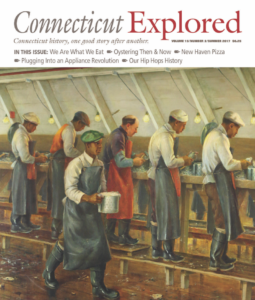 By Elizabeth J. Normen
By Elizabeth J. Normen
(c) Connecticut Explored Inc. Summer 2017
The theme of this issue—food and agriculture—is not only seasonally on point, it’s fertile territory. The last time we dug into Connecticut’s historic foodways was Spring 2006. In that issue we featured stories about émigré Jewish farmers in eastern Connecticut, the state fish (American shad), America’s first cookbook, our favorite diners, and how Connecticut Native Americans’ cuisine fed the colonists. (Visit ctexplored.org/back-issues-spring-2006/.)
“Historic foodways” is the academic term for the eating habits and culinary practices of a historical period, and studying them tells us interesting things about Connecticut. Our consumption of alcoholic beverages appears to be a case in point.
In Fall 2016’s “The Brotherhood of the State Police,” we learned that the founding of the Connecticut State Police in 1903 had its origins in concern that town sheriffs and constables were inconsistently enforcing laws regulating alcohol. That concern had existed at least since 1871 when a bill to establish a state police was proposed and defeated. More evidence is the fact, as we learn in “Connecticut’s Hopyards” in this issue, that Connecticut passed a prohibition law in 1854 and repealed it in 1872.
Wait. What? Connecticut passed a prohibition law in 1854?
Historian Albert Van Dusen writes in Connecticut (Random House, 1961) that in the 1854 state elections, the Kansas-Nebraska Act (repealing the Missouri Compromise) “hurt the Democrats by temporarily uniting Whigs, Free Soilers, and Prohibitionists…. The same session brought passage of a prohibition act which outlawed all traffic in spirituous liquors except for medicinal purposes.” The Act for Suppression of Intemperance in fact also made exceptions for sacramental, chemical, and mechanical uses, too. All other uses were banned. The act allowed for sale of imported liquor in its original casks and for licensing of manufacturers who paid a minimum $1,000 bond. All liquor sales had to go through agents appointed by the towns. The agent was required to provide detailed reports of sales and all proceeds to the town.
More research would be needed to explain what this was all about and in what ways it would “suppress intemperance.” We know that temperance leagues had been railing against the evils of drink and seeking legislative relief since the 1830s. A quick Google search reveals that Connecticut was not alone and that by 1876 “the prohibitory laws” in Massachusetts, Connecticut, Rhode Island, Michigan, and Pennsylvania had also been repealed. “Thus [were]carried five states to the rum side,” lamented James Black in his tract “Is There a Necessity for a Prohibition Party?”(National Temperance Society, 1876).
Van Dusen goes on to explain that in Connecticut, “public enthusiasm for the prohibition experiment quickly faded, and within a decade the law became a dead letter.” That may be why we’ve never heard of Connecticut’s prohibition law and why some were calling for its enforcement through a state police force the year before it was repealed and Connecticut was carried to “the rum side.”
Some 50 years later, when national prohibition passed in 1920, Connecticut and Rhode Island were the only two states that didn’t ratify the amendment. But some traditions hung on: our Blue Law prohibiting liquor sales on Sunday remained in force until 2012.
Cheers! We hope you enjoy this issue, perhaps accompanied by a cold local brew and a freshly shucked local oyster.
